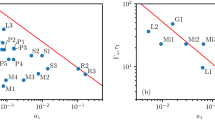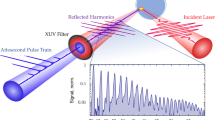Abstract
Contemporary high-power laser systems make use of solid-state laser technology to reach petawatt pulse powers. The breakdown threshold for optical components in these systems, however, demands metre-scale beams. Raman amplification of laser beams promises a breakthrough by the use of much smaller amplifying media, that is, millimetre-diameter plasmas, but so far only 60 GW peak powers have been obtained in the laboratory, far short of the desired multipetawatt regime. Here we show, through the first large-scale multidimensional particle-in-cell simulations of this process, that multipetawatt peak powers can be reached, but only in a narrow parameter window dictated by the growth of plasma instabilities. Raman amplification promises reduced cost and complexity of intense lasers, enabling much greater access to higher-intensity regimes for scientific and industrial applications. Furthermore, we show that this process scales to short wavelengths, enabling compression of X-ray free-electron laser pulses to attosecond duration.
This is a preview of subscription content, access via your institution
Access options
Subscribe to this journal
Receive 12 print issues and online access
$209.00 per year
only $17.42 per issue
Buy this article
- Purchase on Springer Link
- Instant access to full article PDF
Prices may be subject to local taxes which are calculated during checkout





Similar content being viewed by others
References
Shvets, G. et al. Superradiant amplification of an ultrashort laser pulse in a plasma by a counterpropagating pump. Phys. Rev. Lett. 81, 4879–4882 (1998).
Malkin, V. M. et al. Fast compression of laser beams to highly overcritical powers. Phys. Rev. Lett. 82, 4448–4451 (1999).
Forslund, D. W., Kindel, J. M. & Lindman, E. L. Theory of stimulated scattering processes in laser-irradiated plasmas. Phys. Fluids 18, 1002–1016 (1975).
Malkin, V. M. et al. Detuned Raman amplification of short laser pulses in plasma. Phys. Rev. Lett. 84, 1208–1211 (2000).
Malkin, V. M. et al. Ultra-powerful compact amplifiers for short laser pulses. Phys. Plasmas 7, 2232–2240 (2000).
Malkin, V. M. et al. Stimulated Raman scattering of rapidly amplified short laser pulses. Phys. Rev. Lett. 85, 4068–4071 (2000).
Tsidulko, Yu. A. et al. Suppression of superluminous precursors in high-power backward Raman amplifiers. Phys. Rev. Lett. 88, 235004 (2002).
Ersfeld, B. & Jaroszynski, D. A. Superradiant linear amplification in plasma using a chirped pump pulse. Phys. Rev. Lett. 95, 165002 (2005).
Malkin, V. M. & Fisch, N. J. Quasitransient regimes of backward Raman amplification of intense X-ray pulses. Phys. Rev. E 80, 046409 (2009).
Lee, H. J. et al. Simulation of laser pulse amplification in a plasma by a counterpropagating wave. IEEE Trans. Plasma Sci. 30, 40–41 (2002).
Mardahl, P. et al. Intense laser pulse amplification using Raman backscatter in plasma channels. Phys. Lett. A 296, 109–116 (2002).
Fraiman, G. M. et al. Robustness of laser phase fronts in backward Raman amplifiers. Phys. Plasmas 9, 3617–3624 (2002).
Balakin, A. A. et al. Noise suppression and enhanced focusability in plasma Raman amplifier with multi-frequency pump. Phys. Plasmas 10, 4856–4864 (2003).
Clark, D. S. & Fisch, N. J. Operating regime for a backward Raman laser amplifier in preformed plasma. Phys. Plasmas 10, 3363–3370 (2003).
Hur, M. S. et al. Slowly varying envelope kinetic simulations of pulse amplification by Raman backscattering. Phys. Plasmas 11, 5204–5211 (2004).
Clark, D. S. & Fisch, N. J. Raman laser amplification in preformed and ionizing plasmas. Laser Part. Beams 23, 101–106 (2005).
Balakin, A. A. et al. Three-dimensional simulation of backward Raman amplification. IEEE Trans. Plasma Sci. 33, 488–489 (2005).
Hur, M. S. et al. Electron kinetic effects on Raman backscatter in plasmas. Phys. Rev. Lett. 95, 115003 (2005).
Andreev, A. A. et al. Short light pulse amplification and compression by stimulated Brillouin scattering in plasmas in the strong coupling regime. Phys. Plasmas 13, 053110 (2006).
Ping, Y. et al. Amplification of ultrashort laser pulses by a resonant Raman scheme in a gas-jet plasma. Phys. Rev. Lett. 92, 175007 (2004).
Dreher, M. et al. Observation of superradiant amplification of ultrashort laser pulses in a plasma. Phys. Rev. Lett. 93, 095001 (2004).
Cheng, W. et al. Reaching the nonlinear regime of Raman amplification of ultrashort laser pulses. Phys. Rev. Lett. 94, 045003 (2005).
Kirkwood, R. K. et al. Amplification of an ultrashort pulse laser by stimulated Raman scattering of a 1 ns pulse in a low density plasma. Phys. Plasmas 14, 113109 (2007).
Ren, J. et al. A new method for generating ultraintense and ultrashort laser pulses. Nature Phys. 3, 732–736 (2007).
Fisch, N. J. & Malkin, V. M. Generation of ultrahigh intensity laser pulses. Phys. Plasmas 10, 2056–2063 (2003).
Malkin, V. M. & Fisch, N. J. Manipulating ultraintense laser pulses in plasmas. Phys. Plasmas 12, 044507 (2005).
Malkin, V. M., Fisch, N. J. & Wurtele, J. S. Compression of powerful X-ray pulses to attosecond durations by stimuated Raman backscattering in plasmas. Phys. Rev. E 75, 026404 (2007).
Ross, I. N. et al. The prospects for ultrashort pulse duration and ultrahigh intensity using optical parametric chirped pulse amplifiers. Opt. Commun. 144, 125–133 (1997).
Checkhlov, O. et al. Development of petawatt laser amplification systems at the central laser facility. Proc. SPIE 6735, 67350J (2007).
Max, C. E., Arons, J. & Langdon, A. B. Self-modulation and self-focusing of electromagnetic waves in plasmas. Phys. Rev. Lett. 33, 209–212 (1974).
Sprangle, P., Tang, C-M. & Esarey, E. Relativistic self-focusing of short-pulse radiation beams in plasmas. IEEE Trans. Plasma Sci. 15, 145–153 (1987).
Kaw, P., Schmidt, G. & Wilcox, T. Filamentation and trapping of electromagnetic radiation in plasmas. Phys. Fluids 16, 1522–1525 (1973).
Verboncoeur, J. P., Langdon, A. B. & Gladd, N. T. An object-oriented electromagnetic PIC code. Comput. Phys. Commun. 87, 199–211 (1995).
Fonseca, R. A., Silva, L. O. & Hemker, R. G. et al. OSIRIS, a three-dimensional fully relativistic particle in cell code for modeling plasma based accelerators. Lect. Not. Comput. Sci. 2331, 342–351 (2002).
Malkin, V. M. & Fisch, N. J. Quasitransient regimes of backward Raman amplification of intense X-ray pulses. Phys. Rev. E 80, 046409 (2009).
Rosenbluth, M. N. & Liu, C. S. Excitation of plasma waves by two laser beams. Phys. Rev. Lett. 29, 701–705 (1972).
Vu, H. X., Dubois, D. F. & Bezzerides, B. Transient enhancement and detuning of laser-driven parametric instabilities by particle trapping. Phys. Rev. Lett. 86, 4306–4309 (2001).
Vu, H. X., Dubois, D. F. & Bezzerides, B. Kinetic inflation of stimulated Raman backscatter in regimes of high linear Landau damping. Phys. Plasmas 9, 1745–1763 (2002).
Strozzi, D. J. et al. Kinetic enhancement of Raman backscatter, and electron acoustic Thomson scatter. Phys. Plasmas 14, 013104 (2007).
Bilato, R. & Brambilla, M. On the nature of ‘collisionless’ Landau damping. Commun. Nonlinear Sci. Numer. Simul. 13, 18–23 (2008).
Lauterborn, W., Kurz, T. & Wiesenfeldt, M. Coherent Optics: Fundamentals and Applications (Springer, 1999).
Acknowledgements
This work was supported by the STFC Accelerator Science and Technology Centre, by the STFC Centre for Fundamental Physics, by EPSRC through grant EP/G04239X/1 and by FCT (Portugal) through grant PTDC/FIS/66823/2006. We would like to thank W. Mori for discussions, the Plasma Theory and Simulation Group of UC Berkeley for the use of XOOPIC and the OSIRIS consortium for the use of OSIRIS. Simulations were carried out on the Scarf-Lexicon Cluster (STFC RAL), the IST Cluster (IST Lisbon) and the Hoffman Cluster (UCLA).
Author information
Authors and Affiliations
Contributions
R.M.G.M.T.: simulations, data analysis and manuscript preparation. F.F.: simulations, data analysis and analytic theory. R.B.: data analysis and analytic theory. R.A.F.: code and algorithm development. L.O.S.: data analysis and manuscript preparation. R.A.C.: physics of Raman amplification and interpretation of simulations. P.A.N.: data analysis and manuscript preparation.
Corresponding author
Ethics declarations
Competing interests
The authors declare no competing financial interests.
Rights and permissions
About this article
Cite this article
Trines, R., Fiúza, F., Bingham, R. et al. Simulations of efficient Raman amplification into the multipetawatt regime. Nature Phys 7, 87–92 (2011). https://doi.org/10.1038/nphys1793
Received:
Accepted:
Published:
Issue Date:
DOI: https://doi.org/10.1038/nphys1793
This article is cited by
-
Efficient generation and amplification of intense vortex and vector laser pulses via strongly-coupled stimulated Brillouin scattering in plasmas
Communications Physics (2024)
-
Laser pulse compression by a density gradient plasma for exawatt to zettawatt lasers
Nature Photonics (2023)
-
The role of transient plasma photonic structures in plasma-based amplifiers
Communications Physics (2023)
-
Review of laser-plasma physics research and applications in Korea
Journal of the Korean Physical Society (2022)
-
High order mode structure of intense light fields generated via a laser-driven relativistic plasma aperture
Scientific Reports (2020)



